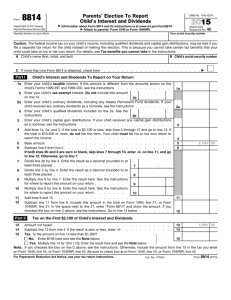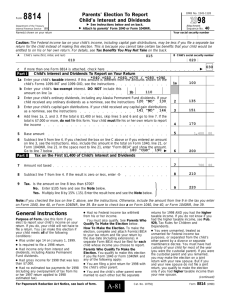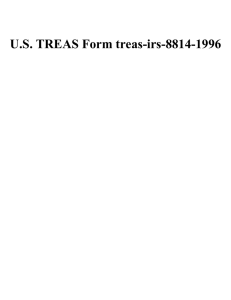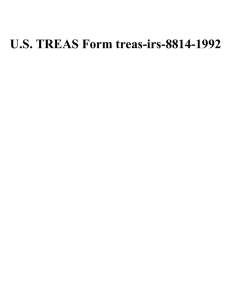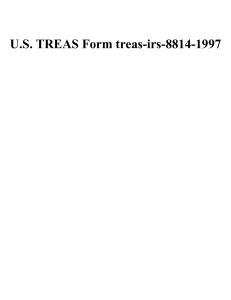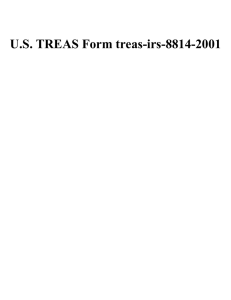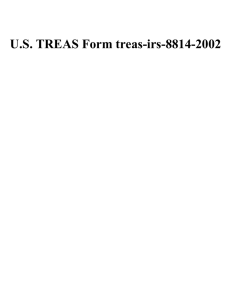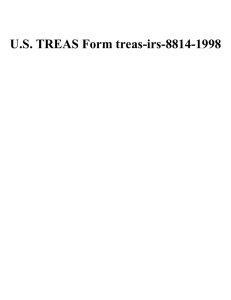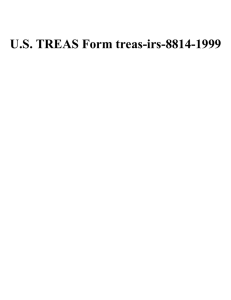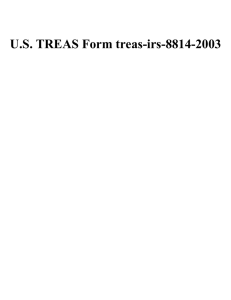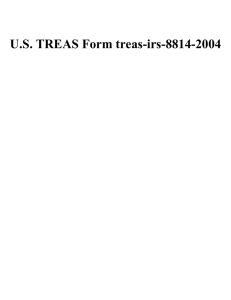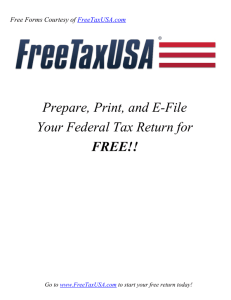U.S. TREAS Form treas-irs-8814-1995
advertisement
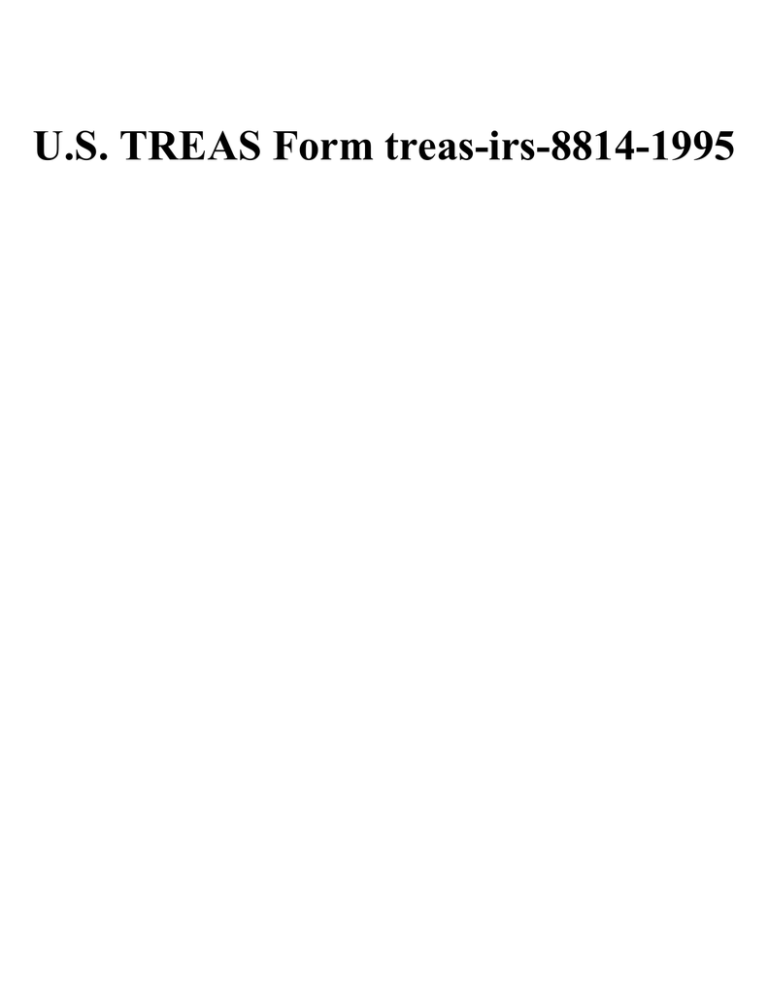
U.S. TREAS Form treas-irs-8814-1995 Form 8814 Department of the Treasury Internal Revenue Service Parents’ Election To Report Child’s Interest and Dividends � OMB No. 1545-1128 � See instructions below and on back. Attach to parents’ Form 1040 or Form 1040NR. Attachment Sequence No. B Child’s social security number A Child’s name (first, initial, and last) C � If more than one Form 8814 is attached, check here Step 1 40 Your social security number Name(s) shown on your return Figure amount of child’s interest and dividend income to report on your return 1a Enter your child’s taxable interest income. If this amount is different from the amounts shown on the child’s Forms 1099-INT and 1099-OID, see the instructions b Enter your child’s tax-exempt interest income. DO NOT include this amount on line 1a 1a 1b 2a Enter your child’s gross dividends, including any Alaska Permanent Fund dividends. If none, enter -0- on line 2c and go to line 3. If your child received any capital gain distributions or dividends as a 2a nominee, see the instructions b Enter your child’s nontaxable distributions that are included on line 2b 2a. These should be shown in box 1d of Form 1099-DIV 2c c Subtract line 2b from line 2a 3 Add lines 1a and 2c. If the total is $1,000 or less, skip lines 4 and 5 and go to line 6. If the total is $5,000 or more, do not file this form. Your child must file his or her own return to report the income 3 4 Base amount 4 5 Subtract line 4 from line 3. If you checked the box on line C above or if line 2a includes any capital gain distributions, see the instructions. Also, include this amount in the total on Form 1040, line 21, or Form 1040NR, line 21. In the space next to line 21, enter “Form 8814” and � show the amount. Go to line 6 below 5 Step 2 1,000 00 Figure your tax on the first $1,000 of child’s interest and dividend income 6 Amount not taxed 6 7 Subtract line 6 from line 3. If the result is zero or less, enter -0­ 7 8 Tax. Is the amount on line 7 less than $500? NO. Enter $75 here and see the Note below. YES. Multiply line 7 by 15% (.15). Enter the result here and see the Note below. � 500 00 8 Note: If you checked the box on line C above, see the instructions. Otherwise, include the amount from line 8 in the tax you enter on Form 1040, line 38, or Form 1040NR, line 37. Also, enter the amount from line 8 in the space provided next to line 38 on Form 1040, or next to line 37 on Form 1040NR. General Instructions Purpose of Form.—Use this form if you elect to report your child’s income on your return. If you do, your child will not have to file a return. You can make this election if your child meets all of the following conditions: ● Was under age 14 on January 1, 1996. ● Is required to file a 1995 return. ● Had income only from interest and dividends, including Alaska Permanent Fund dividends. ● Had gross income for 1995 that was less than $5,000. ● Had no estimated tax payments for 1995. ● Did not have any overpayment of tax shown on his or her 1994 return applied to the 1995 return. ● Had no Federal income tax withheld from his or her income. You must also qualify as explained on page 2 of these instructions. Step 1 of the form is used to figure the amount of your child’s income to report on your return. Step 2 is used to figure an additional tax that must be added to your tax. For Paperwork Reduction Act Notice, see back of form. How To Make the Election.—To make the election, complete and attach Form 8814 to your tax return and file your return by the due date (including extensions). A separate Form 8814 must be filed for each child whose income you choose to report. Caution: The Federal income tax on your child’s income may be less if you file a tax return for the child instead of making this election. This is because you cannot take certain deductions that your child would be entitled to on his or her own return. For details, see Deductions You May Not Take on page 2. Cat. No. 10750J Form 8814 (1995) Form 8814 (1995) Parents Who Qualify To Make the Election.—You qualify to make this election if you file Form 1040 or Form 1040NR and any of the following apply: ● You are filing a joint return for 1995 with the child’s other parent. ● You and the child’s other parent were married to each other but file separate returns for 1995 AND you had the higher taxable income. If you do not know if you had the higher taxable income, get Pub. 929, Tax Rules for Children and Dependents. ● You were unmarried, treated as unmarried for Federal income tax purposes, or separated from the child’s other parent by a divorce or separate maintenance decree. You must have had custody of your child for most of the year (you were the custodial parent). If you were the custodial parent and you remarried, you may make the election on a joint return with your new spouse. But if you and your new spouse do not file a joint return, you qualify to make the election only if you had higher taxable income than your new spouse. Note: If you and the child’s other parent were not married but lived together during the year with the child, you qualify to make the election only if you are the parent with the higher taxable income. Deductions You May Not Take.—If you elect to report your child’s income on your return, you may not take any of the following deductions that your child would be entitled to on his or her own return. ● Standard deduction of $650 ($1,600 for a blind child). ● Penalty on early withdrawal of child’s savings. ● Itemized deductions such as child’s investment expenses or charitable contributions. If any of the above apply to your child, first figure the tax on your child’s income as if he or she is filing a return. Next, figure the tax as if you are electing to report your child’s income on your return. Then, compare the methods to determine which results in the lower tax. Alternative Minimum Tax.—If your child received any tax-exempt interest (or exempt-interest dividends paid by a regulated investment company) from certain private activity bonds, you must take this into account in determining if you owe the alternative minimum tax. Get Form 6251, Alternative Minimum Tax— Individuals, and its instructions for details. Investment Interest Expense.—Your child’s income (excluding Alaska Permanent Fund dividends and capital gain distributions) that you report on your return is considered to be your investment income for purposes of figuring your investment interest expense deduction. If your child received Alaska Permanent Fund dividends or capital gain distributions, get Pub. 550, Investment Income and Expenses, to figure the amount you may treat as your investment income. Page Foreign Accounts and Trusts.—If your child had a foreign financial account or was the grantor of, or transferor to, a foreign trust, complete Part III of Schedule B (Form 1040) for the child. If you answered “Yes” to either of the questions, you must file this Schedule B with your return. Also, complete line 11b if applicable. Write “Form 8814” next to line 11a or line 12, whichever applies. Change of Address.—If your child filed a return for a year before 1995 and the address shown on the last return filed is not your child’s current address, be sure to notify the IRS, in writing, of the new address. To do this, you may use Form 8822, Change of Address, or you may write to the Internal Revenue Service Center where your child’s last return was filed, or to the Chief, Taxpayer Service Division, in your local IRS district office. Additional Information.—For more details, see Pub. 929. Line Instructions Name and Social Security Number.— Enter your name as shown on your return. If filing a joint return, include your spouse’s name but enter the social security number of the person whose name is shown first on the return. Line 1a.—Enter ALL taxable interest income received by your child in 1995. If your child received a Form 1099-INT for tax-exempt interest, such as from municipal bonds, write the amount and “Tax-exempt interest” on the dotted line next to line 1a. Be sure to include this interest on line 1b but do not include it in the total for line 1a. If your child received, as a nominee, interest that actually belongs to another person, write the amount and “ND” (for nominee distribution) on the dotted line next to line 1a. Do not include amounts received as a nominee in the total for line 1a. If your child had accrued interest that was paid to the seller of a bond, amortizable bond premium (ABP) allowed as a reduction to interest income, or if any original issue discount (OID) included on line 1a is less than the amount shown on your child’s Form 1099-OID, follow the instructions above for nominee interest to see how to report the nontaxable amounts. But on the dotted line next to line 1a, write the nontaxable amount and “Accrued interest,” “ABP adjustment,” or “OID adjustment,” whichever applies. Do not include any nontaxable amounts in the total for line 1a. Line 1b.—If your child received any tax­ exempt interest income, such as interest on certain state and municipal bonds, enter the total tax-exempt interest on line 1b. Also, include any exempt-interest dividends your child received as a shareholder in a mutual fund or other regulated investment company. Do not include this interest on lines 1a or 3. Note: If line 1b includes tax-exempt interest or exempt-interest dividends paid Printed on recycled paper 2 by a regulated investment company from private activity bonds, see Alternative Minimum Tax on this page. Line 2a.—Enter gross dividends received by your child in 1995, including capital gain distributions and nontaxable distributions. Gross dividends should be shown in box 1a of Form 1099-DIV. Also, include dividends your child received through a partnership, an S corporation, or an estate or trust. If line 2a includes any capital gain distributions, see the line 5 instructions below. These should be shown in box 1c of Form 1099-DIV. If your child received, as a nominee, dividends that actually belong to another person, write the amount and “ND” on the dotted line next to line 2a. Do not include amounts received as a nominee in the total for line 2a. Line 5.—If you checked the box on line C, add the amounts from line 5 of all your Forms 8814. Include the total on line 21 of Form 1040 or Form 1040NR, whichever applies. Be sure to write “Form 8814” and show the total of the line 5 amounts in the space next to line 21. Caution: At the time these instructions were printed, Congress was considering legislation that would change the tax treatment of capital gains, including capital gain distributions. For information on the changes, get Pub. 553, Highlights of 1995 Tax Changes. If line 2a includes any capital gain distributions and you are filing Schedule D (Form 1040) OR can use the Capital Gain Tax Worksheet, part or all of those distributions should be reported on your Schedule D or on Form 1040 or Form 1040NR instead of on Form 8814, line 5. See Pub. 929 for details. Line 8.—If you checked the box on line C, add the amounts from line 8 of all your Forms 8814. Include the total on Form 1040, line 38, or Form 1040NR, line 37. Be sure to enter the total of the line 8 amounts in the space provided next to line 38 on Form 1040 or next to line 37 on Form 1040NR. Paperwork Reduction Act Notice.—We ask for the information on this form to carry out the Internal Revenue laws of the United States. You are required to give us the information. We need it to ensure that you are complying with these laws and to allow us to figure and collect the right amount of tax. The time needed to complete and file this form will vary depending on individual circumstances. The estimated average time is: Recordkeeping, 20 min.; Learning about the law or the form, 8 min.; Preparing the form, 16 min.; and Copying, assembling, and sending the form to the IRS, 35 min. If you have comments concerning the accuracy of these time estimates or suggestions for making this form simpler, we would be happy to hear from you. See the instructions for the tax return with which this form is filed.
